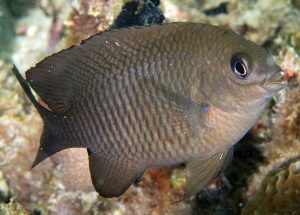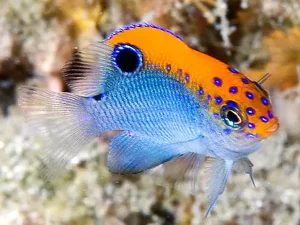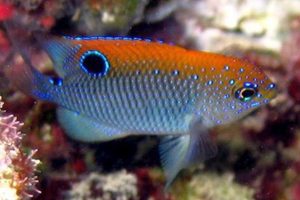Dusky Damselfish (Stegastes adustus syn. Stegastes dorsopunicans) known to tropical fish keeping enthusiasts as the Scarlet Backed Damselfis and Scarlet Backed Demoiselle is found in tropical waters of the Western Central Atlantic from Florida, the Gulf of Mexico, the Caribbean Sea, and along the coast of central America, to Panama and Venezuela. It has also been observed in the Bahamas and the Antilles.
Adult Dusky Damselfish are a demersal species that inhabit rocky shores exposed to wave action and the high energy surge zones along the outer edges of shallow inshore reefs at depths from 3 to over 60 feet.
Although Dusky Damselfish have been encountered as deep as 65 feet, they normally prefer shallower waters within the surge zone in depths less than 15 feet where they forage primarily on algae, plants, detritus, benthic invertebrates, and plankton. They are often found swimming in tidal pools.
Stegastes adustus are an aggressive, non migratory, midwater species that occasionally make their way into the aquarium trade as juveniles.
Juvenile Stegastes adustus have a reddish orange body color with a red-brown cap on the nape of the neck and upper edge of the body and small bright blue spotted lines on the forehead and upper front of the body, and a large black, blue ringed ocellus on the lower part of the dorsal fin and upper body adjacent to the dorsal spines. Another smaller black spot ringed in blue is on the upper base of the caudal fin.
As Dusky Damselfish mature into adults, they lose their bright body colors and develop a blackish, dark gray, or chocolate brown body color with vertical black lines and a black spot, sometimes diffused, at the upper base of the pale pectoral fins. The other fins are the same color as the body except for a narrow dark to blueish edge on the anal fin. The dorsal and anal fins do not extend beyond where the tail fin rays join the base of the tail. Adults are similar in nature and body shape to freshwater bluegills.
Dusky Damselfish are often confused with the Beaugregory (Stegastes leucostictus) that has blue dorsally and yellow ventrally; the Bicolor Damselfish (Stegastes partitus) with white on the rear half of body; the Cocoa Damselfish (Stegastes variabilis) with yellow caudal and pectoral fins; the Freshwater Gregory (Stegastes otophorous) with yellow anal, caudal, dorsal, and pectoral fin tips; the Longfin Damselfish (Stegastes diencaeus) with a blue line at the marginof the anal fin and blue pectoral fins; the Purple Reeffish (Chromis scotti) with a blue and gray color; and the Yellowtail Damselfish (Microspathodon chrysurus) with blue spots on the upper body.
Dusky Damselfish are a large, territorial, and quite pugnacious species that should be housed alone in a reef or FOWLR aquarium of at least 100 gallon capacity with a sandy or fine crushed coral substrate and plenty of mature live rock arranged into caves, crevices, and overhangs for hiding among. Adult Dusky Damselfish can quickly become the dominant species in the tank and although they are extremely aggressive, they are still considered reef safe, with caution. In larger aquariums, they can be housed with other semi aggressive to aggressive species so long as plenty of free swimming area and mature live rock is provided.
Whether Dusky Damselfish have been in an aquarium environment is unknown. Adults display distinct pairing during breeding and vigorously defend their territories against intruders. After a brief courtship ritual, the female will lay a mass of small adhesive eggs on the substrate. The male will immediately fertilize the eggs, stand guard, and aerate the demersal eggs until the larvae hatch out. The tiny fry in their larval stage drift with the current as plankton feeding on zooplankton and phytoplankton before settling to the bottom as partially developed damselfish.
In their natural habitat, adult Dusky Damselfish feed on algae, plants, and detritus. Individuals living in coral rubble exhibit different feeding behaviors than those in patch reef habitats, however, in an aquarium environment they are not picky about their food and will aggressively eat a varied diet of green and meaty foods. A varied diet of live, frozen, or freeze dried Spirulina, herbivore flakes, Mysis shrimp
, brine shrimp, finely chopped clams, fresh fish, etc. will be eagerly accepted. Feeding several times a day is recommended.
Dusky Damselfish (Stegastes adustus) are occasionally seen in the aquarium trade as juveniles but are not a commonly stocked item. Tropical fish keeping enthusiasts can occasionally find them online from divers, wholesalers, trans shippers, and retailers or back order them at prices varying from $10.99 to over $14.99.
Minimum Tank Size: 100 gallons
Aquarium Type: Reef or FOLR
Care Level: Easy
Temperament: Semi Aggressive
Aquarium Hardiness: Hardy
Water Conditions: 74-82° F, dKH 8 to 12, pH 7.9-8.5, sg 1.020-1.027
Max size: 4.9″
Color Form: Black, Orange, Blue
Diet: Omnivore
Compatibility: Reef
Origin: Western Central Atlantic
Family: Pomacentridae
Lifespan: over 5 years
Aquarist Experience Level: Beginner




